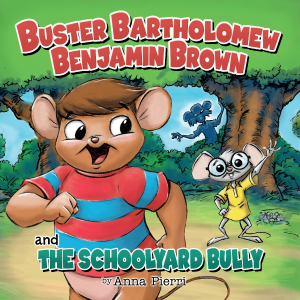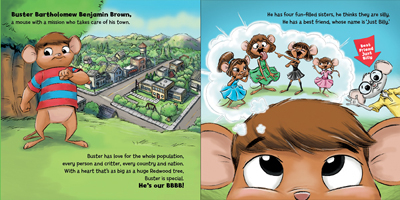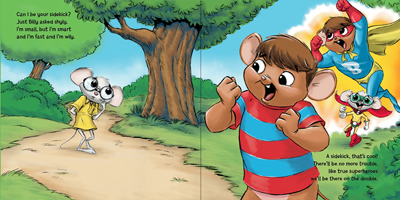| ________________
CM . . .
. Volume XXIV Number 35. . . .May 11, 2018

 |
Buster Bartholomew Benjamin Brown and the School Yard Bully.
Anna Pierri. Illustrated by Steve Slawich.
Toronto, ON: Ruby Two Shoes Publishing, 2017.
32 pp., pbk., $12.95.
ISBN 978-1-7750715-0-1.
Preschool-grade 2 / Ages 4-7.
Review by Dave Jenkinson.
**½ /4
|
| |
|

excerpt:
Buster Bartholomew Benjamin Brown,
a mouse with a mission who takes care of his town.
Buster has love for the whole population,
every person and critter, every country and nation.
With a heart that’s as big as a huge Redwood tree,
Buster is special.
He’s our BBBB!
He has four fun-filled sisters, he thinks they are silly.
He has a best friend, whose name is “Just Billy.”
According to a note on the back cover, Buster Bartholomew Benjamin Brown and the School Yard Bully is the first book in a projected series. I suspect that the text of the opening two pages [see excerpt above] may be used as the introductory pages of further books in the series as the text provides an overview of who Buster is while introducing what are likely to be continuing characters. Buster obviously sees himself as a kind of self-appointed superhero whose life mission is to take care of his town, though his exact motivation for doing so remains unclear.
 Buster, an anthropomorphic mouse, is almost seven and big for his age. Though the opening text says Buster has a friend Billy, it’s actually this title that brings the two together when, by chance, they meet in a park and begin playing together. After Buster introduces himself by using all four parts of his alliterative name, Billy’s self-introduction response is, “Just Billy. That’s me.” Billy is already seven, and he describes himself as “really wee” and shares that his diminutive size has made him the target of bullies, especially Rocky Ratnick. Seeing battling bullies to be part of his life mission, Buster takes on Just Billy as his sidekick. Buster, an anthropomorphic mouse, is almost seven and big for his age. Though the opening text says Buster has a friend Billy, it’s actually this title that brings the two together when, by chance, they meet in a park and begin playing together. After Buster introduces himself by using all four parts of his alliterative name, Billy’s self-introduction response is, “Just Billy. That’s me.” Billy is already seven, and he describes himself as “really wee” and shares that his diminutive size has made him the target of bullies, especially Rocky Ratnick. Seeing battling bullies to be part of his life mission, Buster takes on Just Billy as his sidekick.
With Buster’s assurance that on Monday the two of them will take care of the bullies, Just Bully shows up at school well before dawn. Of course, Rocky Ratnick does his bully thing before Buster arrives, but when Buster sees what has occurred, he jumps on Rocky, using his larger size to pin the bully down. A teacher intervenes and accuses Buster of bullying Rocky Ratnick. After Buster explains what his actual role had been, the teacher apologizes, but she adds:
But jumping on Rocky
does not make things right.
We must reason with bullies
and not use our might.
In this great world of ours
we should love not fight.
Buster acknowledges the truth in what the teacher has said and responds:
We’ve all learned a lesson and now we all know,
we should try to be friends and not fight with a foe.
Because you are bigger and have strength and might,
you should use it for good – not to bully and fight.
The book’s message regarding bullying is one that parents should want their children to know and practice. The one small weakness is that, while Buster has stated his intention to change his behavior, there is nothing to indicate that Rocky Ratnick intends to do so as well.
Only one of Buster’s four sisters, his kid sister Lily, makes a cameo appearance, that being to tell him to come home from the park immediately because his mother is “frantic and worried and mad”. “Get home this minute or I will tell Dad!”, she threatens as only an annoying little sister can.
Pierri’s text largely takes the form of quatrains which principally employ an AABB or ABCB rhyme scheme. Overall, the poetry reads smoothly, and the alliterative, rhythmic name of the central character almost invites readers to join in saying it as the text is being read.
 Slawich’s cartoon-style illustrations are not only fun, but they contribute to characterization. A nice addition to the portrayal of the bullied diminutive Just Billy is Slawich’s having Billy’s glasses being held together at the bridge by tape, the damage possibly/obviously having been one result of his being picked on.
Slawich’s cartoon-style illustrations are not only fun, but they contribute to characterization. A nice addition to the portrayal of the bullied diminutive Just Billy is Slawich’s having Billy’s glasses being held together at the bridge by tape, the damage possibly/obviously having been one result of his being picked on.
Buster Bartholomew Benjamin Brown and the School Yard Bully is a worthwhile school and public library purchase.
Recommended.
Dave Jenkinson, CM’s editor, lives in Winnipeg, MB.

© CM Association
CC BY-NC-ND
Hosted by:
University of Manitoba
ISSN 1201-9364
|
This Creative Commons license allows you to download the review and share it with others as long as you credit the CM Association. You cannot change the review in any way or use it commercially.
Commercial use is available through a contract with the CM Association. This Creative Commons license allows publishers whose works are being reviewed to download and share said CM reviews provided you credit the CM Association. |
Next Review | Table of Contents for This Issue - May 11, 2018.
CM Home | Back Issues | Search | CM Archive | Profiles Archive
|

 Buster, an anthropomorphic mouse, is almost seven and big for his age. Though the opening text says Buster has a friend Billy, it’s actually this title that brings the two together when, by chance, they meet in a park and begin playing together. After Buster introduces himself by using all four parts of his alliterative name, Billy’s self-introduction response is, “Just Billy. That’s me.” Billy is already seven, and he describes himself as “really wee” and shares that his diminutive size has made him the target of bullies, especially Rocky Ratnick. Seeing battling bullies to be part of his life mission, Buster takes on Just Billy as his sidekick.
Buster, an anthropomorphic mouse, is almost seven and big for his age. Though the opening text says Buster has a friend Billy, it’s actually this title that brings the two together when, by chance, they meet in a park and begin playing together. After Buster introduces himself by using all four parts of his alliterative name, Billy’s self-introduction response is, “Just Billy. That’s me.” Billy is already seven, and he describes himself as “really wee” and shares that his diminutive size has made him the target of bullies, especially Rocky Ratnick. Seeing battling bullies to be part of his life mission, Buster takes on Just Billy as his sidekick.
 Slawich’s cartoon-style illustrations are not only fun, but they contribute to characterization. A nice addition to the portrayal of the bullied diminutive Just Billy is Slawich’s having Billy’s glasses being held together at the bridge by tape, the damage possibly/obviously having been one result of his being picked on.
Slawich’s cartoon-style illustrations are not only fun, but they contribute to characterization. A nice addition to the portrayal of the bullied diminutive Just Billy is Slawich’s having Billy’s glasses being held together at the bridge by tape, the damage possibly/obviously having been one result of his being picked on.